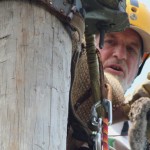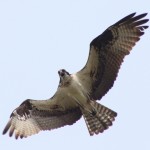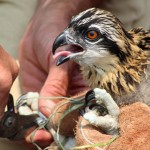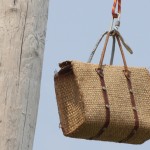Local bird lovers band together

By Greg Seubert
Perched 30 feet above the Wolf River, a female osprey tended to her chicks on a recent sunny Sunday morning as her male counterpart searched for a meal of fish.
Three boats carrying 10 people approached the nest, located about seven miles south of New London in the state-owned 1,300-acre Mukwa Wildlife Area. The mother osprey left the nest shortly before Bob Welch, a science teacher at Waupaca Middle School, shimmied up the manmade structure and carefully sent two chicks down to be examined. She didn’t go far, however, as she kept an eye on the month-old chicks.
Pat Fisher, director of The Feather Rehabilitation Center, a nonprofit organization dedicated to caring for orphaned or injured avian wildlife, organized the trip that also included visits to osprey platforms in New London.
“I’m doing it to help a friend because this is her program,” Welch said. “She comes out to my bird banding sessions in the spring and I come here to help her with ospreys.”
Ospreys don’t have the reputation of the bald eagle, but both birds were hit hard in the 1960s and 1970s by DDT (dichlorodiphenyltrichloroethane) a colorless, tasteless and almost odorless pesticide made available for use as an agricultural insecticide after World War II.
“Ospreys are pretty cool because they’re a bird of prey that has a pretty northern range into the middle ranges of the provinces of Canada and will migrate into Argentina, one of the longest migrations,” Welch said. “It’s a unique bird because it was severely hit by DDT in the 1970s and is now making a slow but steady comeback. The bald eagle had a faster comeback than the osprey because the osprey is so fish-oriented in its diet where eagles eat a wider range of food. They’ll take anything.”
“Back when DDT was real prevalent, that’s what took out the ospreys,” Fisher said. “The eagles came back and ospreys are starting to come back. Ospreys are doing really good on manmade platforms. Wisconsin has tremendous rivers for ospreys, so our population is doing really good right now.
“It’s not a scavenger like the eagle,” she added. “They’re only eating fish and they have to get their meals. They’re really workhorses when it comes to birds of prey. They’re such good parents, but all birds are good parents.”
“Ospreys are a favored bird because it’s a bird of the wetlands and it’s a very important indicator for quality wetlands,” said Welch, who also keeps track of osprey platforms in the Waupaca area. One is located in Lakemen Field, the other off of County Trunk E on the city’s north side.
“As we see them moving into the Waupaca area and spreading across areas where they probably were once there in the 1950s, we are seeing them recolonize their habitats, which is very exciting to see,” he said.
Area nests are also located in New London, Manawa, Weyauwega and Scandinavia.
Once Welch lowered the chicks to safety, Don Baumgartner of New London, a longtime volunteer at The Feather, placed bands on each bird before sending them back up to the next.
“You can now identify your specific bird by a color code on the leg,” Welch said. “Those are excellent ways of seeing known birds come back and you can document how old they are.”
“You find out how long the birds live, where they go, when they come back,” said Fisher, who has organized banding trips for the past decade.
“We had a lot of good support from Michels Electric, WE Energies, Great Lakes Line Builders and American Transmission (Co.),” she said. “You have to have these people to put up the poles. American Transmission was even giving us the platforms at one point. We don’t do this without power companies.”
Ospreys are known to return to the same nesting location for 10 or 15 years, according to Welch, who also works with songbirds such as grosbeaks, orioles and tanagers.
“Having to migrate that distance with all the dangers on that trip and come back is a fantastic thing,” he said.
This year’s banding effort has special meeting for Fisher.
“My granddaughter, Alyssa, died in a car accident in 2003,” she said. “Every year or so, my son gives money to The Feather. I told myself, ‘I’m going to do something worthwhile.’ That’s how we got the color bandings. Every osprey that goes to South America goes in honor of my granddaughter. It’s a really special summer for banding, let me tell you.”
Fisher has to obtain a permit from the U.S. Fish & Wildlife Service for the banding project.
“We don’t need one from the state any more because they’re off the endangered list, but I do need a permit for a banding lab in Laurel, Maryland,” she said.
“This is the highlight of my summer,” she said. “What we need is a lot of younger people to get into this,” she said. “Old people like myself need people to carry it out because it could happen again for some other reason.”




